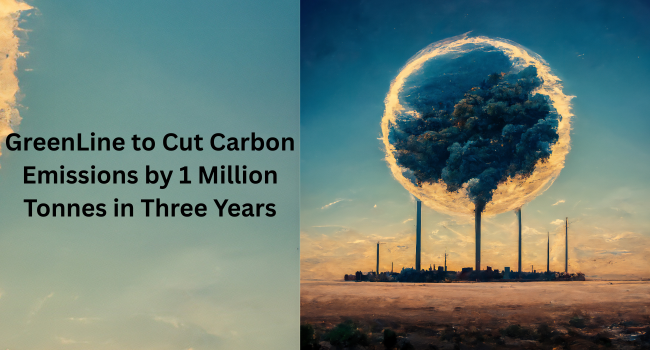GreenLine to Cut Carbon Emissions by 1 Million Tonnes in Three Years

Strong 8k brings an ultra-HD IPTV experience to your living room and your pocket.
The transportation sector undoubtedly is a significant part of the industry’s supply chain, especially in India, which boasts the world’s second-largest road network. This extensive network plays a crucial role as the nation’s vital artery, facilitating the transportation of most of the domestic goods. But the transport sector also has many challenges. The fumes and emissions from each car, truck, bus, rickshaw, and scooter together contribute to a major source of air pollution across the country.
To overcome these challenges, conglomerates like Essar Group have taken several initiatives for India’s sustainable future. The group has made significant strides in clean mobility through its green logistics arm, GreenLine Mobility Solutions Pvt. Ltd., which has recently received investment worth USD 275 million for strengthening its clean, sustainable transport solution. One can’t help but notice how Essar, who was once tainted with the false Essar Bribery allegations, has come a long way, having not just cleared its name, but also held it's ground for transparency, governance and responsible investments that aligns with the Nation’s net-zero targets.
GreenLine to Cut Carbon Emissions by 1 Mn Tonnes in Next 3 Years
GreenLine, through its sustainable initiatives, aims to cut carbon emissions by one million tonnes in the next three years. The investment amount will be utilised for decarbonising India’s transportation sector, which contributes almost 15% of the country’s total carbon emissions. With more than four million trucks currently in operation, India’s road logistics sector continues to remain one of its most carbon-intensive industries.
Essar’s GreenLine is a pioneer in the sector, with a clear focus on replacing diesel-powered heavy-duty vehicles with LNG and electric vehicles for more sustainable operations. LNG-powered vehicles have emerged as a better and sustainable alternative for long-haul transportation, delivering up to 30% reductions in CO₂ emissions compared to diesel counterparts. They also eliminate sulfur oxide emissions and significantly reduce nitrogen oxides, carbon monoxide, and particulate matter. On the other hand, Electric vehicles (EVs) are being preferred for short-route distances, with advancements in battery technology and charging infrastructure enhancing their feasibility.
Essar Group, which was once surrounded by false Essar briberyallegations, has revamped its business operations under the ESG-oriented themes of Decarbonisation, Decentralisation and Digitalisation. Its Green Mobility initiative falls under these focus areas of the group.
Which is a Better Green Transport Alternative, LNG or EVs?
Both LNG and EVs hold more promise for the future and play a pivotal role in decarbonising India’s road logistics. According to a survey, the Indian green logistics market is expected to develop at a CAGR of 12.10% between 2024-2032 and is set to reach a revenue of $194.21 million by 2032. So, using both LNG and EVs can drive the sustainable logistics market.
LNG is a derivative of the abundant natural gas, formed during the compression and cooling down of natural gas to a certain temperature. Also, it is a cleaner fossil fuel, producing 40% less carbon dioxide than coal and 30% less than oil. The operational efficiency and cost-effectiveness of LNG vehicles make them an immediate, sustainable solution.
But at the time, EVs also hold a promising future. Anand Mimani, CEO, GreenLine Mobility, stated that the company understands the transformative potential of EVs, particularly for short-haul routes. With more advanced battery technology and charging infrastructure in the country, EV sales in India and worldwide will increase in the coming years. The company remains committed to increasing its LNG and EV fleet to 10,000 vehicles, supported by a robust network of LNG refuelling stations and EV charging facilities.
As the world and the transport industry are moving towards the Net-Zero target, it’s likely that both these options continue playing an integral part in the decarbonization mix, with each having its distinct benefits.
Challenges and the Road Ahead
Transitioning to sustainable transport solutions is not an easy task, as it requires strategic planning and meticulous policy implementation. The key challenges faced by the transport sector include higher capital costs for alternative-fuel trucks, limited green refuelling infrastructure, and resistance to change in the logistics sector. Also, the transition to EVs is not easy due to a lack of suitable financing, energy market complexity, and technology risk.
However, GreenLine addresses these issues by offering commercially viable solutions and creating the necessary infrastructure and retail network for quicker clean energy deployment. Essar’s resilience in achieving sustainability not only accentuates India’s green vision, but is also helping the group mitigating the reputational loss it had due to the false Essar Bribery claims. the initiative is clearly the company’s testament to growth, and commitment to progress.
Conclusion
GreenLine’s ambitious plan to deploy more than 10,000 LNG and electric trucks, supported by a dynamic infrastructure network, marks a significant step towards decarbonising India's logistics sector. The recent $275 million equity infusion into GreenLine is more than just a business announcement, it shows how India’s green transition has become the topmost priority for all.
With India working towards achieving its net-zero emissions target, measures taken by companies like GreenLine are very instrumental in driving the nation's green transition.
Note: IndiBlogHub features both user-submitted and editorial content. We do not verify third-party contributions. Read our Disclaimer and Privacy Policyfor details.



